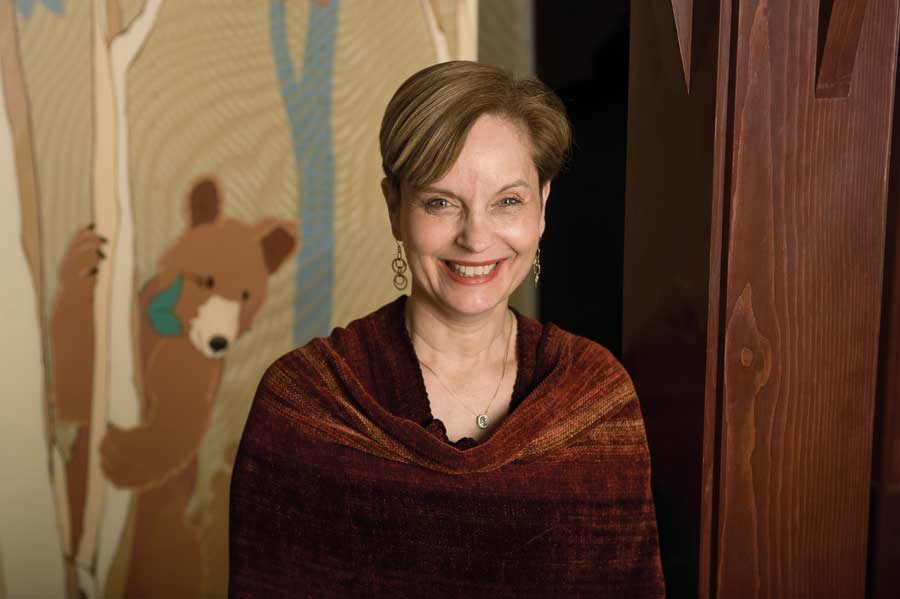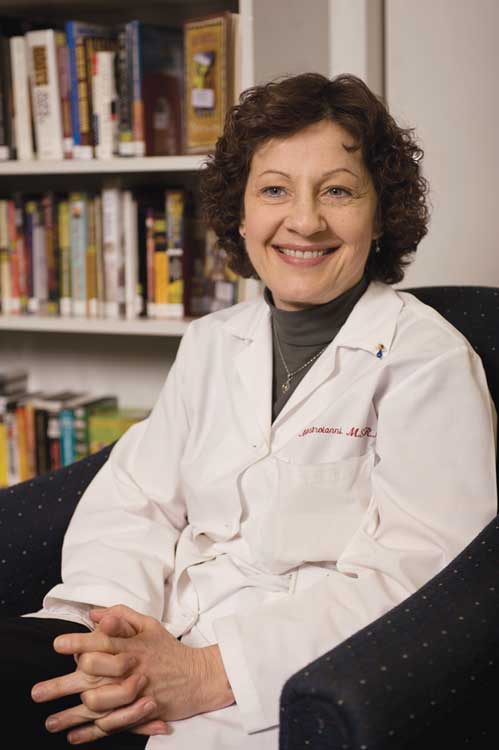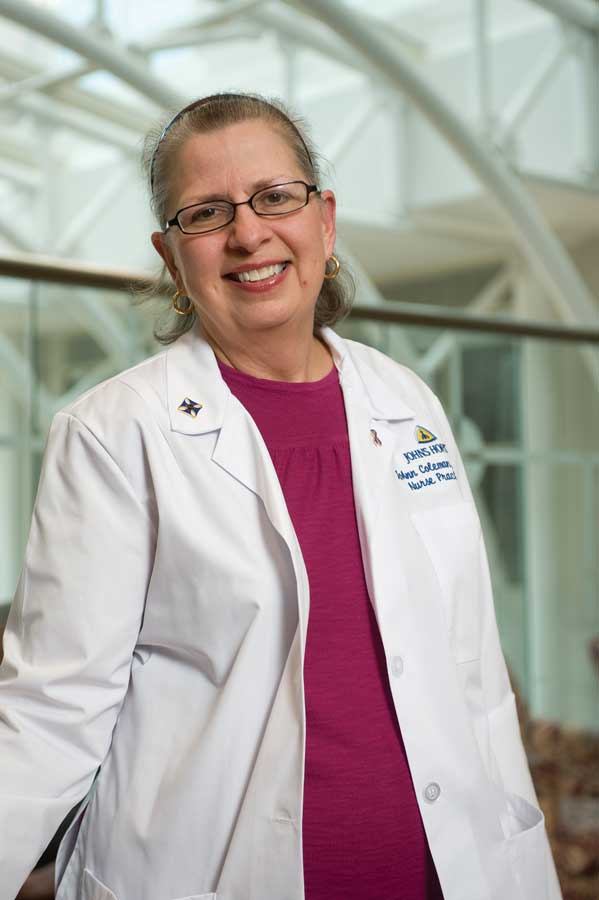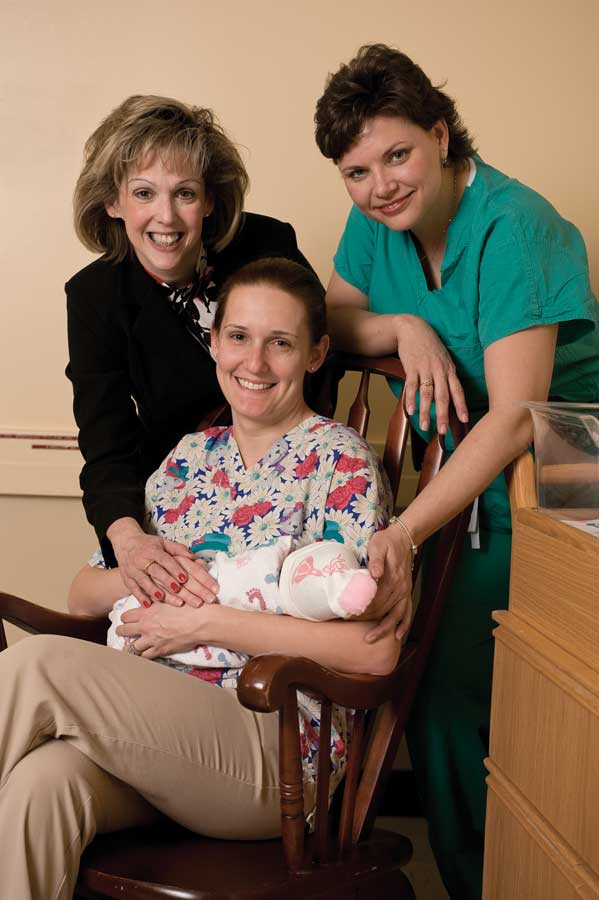News from the Johns Hopkins Hospital Department of Nursing, Johns Hopkins Bayview Medical Center, and Howard County General Hospital (a member of Johns Hopkins Medicine)
The Essence of Nursing: Palliative Care Nurses Provide Comfort, Relieve Suffering
Lynn Billing, BSN, CHPN, knows that that every case in the Sidney Kimmel Cancer Center at Johns Hopkins is unique. But there is one essential commonality among all her patients, male and female, young and old, that drives her work as the Nurse Coordinator for the Center’s Harry J. Duffey Family Pain and Palliative Care Program. “Every cancer patient needs to tell their story,” says Billing, a former home hospice nurse who has worked in the Hopkins Oncology Department for ten years. “Our patients are scared, and when they tell their story, we can assess what their goals are.” Typically, Billing says, these conversations often move from pain to other concerns, such as anxiety, depression, fear, and other issues facing a cancer patient.

Each week, the Duffey Program’s multidisciplinary team consults with about 25 cancer patients and their families on all aspects of pain management and palliative care. Led by physician Sidney Dy, MD, MSc, the team includes a pharmacist, social worker, and chaplain, in addition to nurses Billing, Colleen Apostol, RN, OCN, CHPN, and Andrea Cox, BSN, CHPN. “We aren’t a replacement for the oncology team, but another layer of care,” Billing notes. “The patient’s oncologists are focused on the disease and treatment. The nurses look at the whole person and listen for undertones of issues, such as spirituality. We support the family and educate, sometimes needing to translate medical-ese.”
In spring 2007, the Kimmel Center expanded 20 years of offering palliative care to create the Duffey Program, which is the first formal consultation service for palliative care and pain management at Johns Hopkins. Named in memory of Harry J. Duffey by his wife, Lois Duffey, the Program serves as a clearinghouse for both terminal and non-terminal patients in the Kimmel Center. “You have to develop a trust with a patient,” Apostol adds, of the referrals the program receives from the Kimmel Center’s nurses and oncologists. “The nurses in the Kimmel outpatient clinic have great relationships with their patients, and it’s a privilege to be invited to be part of that relationship.”
Palliative care conversations and services encompass every area of a patient’s spiritual, physical, emotional, psychological, and social care. How does a mother tell her children about her breast cancer? How can the nausea from chemotherapy be managed? What are the issues facing the family? Even finances play a role in the team’s conversations. “I was a bedside nurse for many years, and we rarely talked about finances with a patient,” Apostol recalls. “Now we ask if patients can afford a medication, such as Oxycontin, which is very expensive. If the patient can’t, it doesn’t make sense to order that particular narcotic.”

She and Billing are quick to point out that palliative care does not equal hospice care, a common misconception among patients and clinicians alike. “Palliative care is about empowering patients and their families with knowledge, so they are informed and able to determine their goals of care,” she explains, recalling a case where both the palliative care team and the patient’s doctors recommended hospice as the best choice. The patient, however, wished to continue chemotherapy. Respecting and supporting that decision and managing the physical symptoms or side effects of chemotherapy became the team’s goal. “It is not only about end-of-life issues, it is about quality of life and how to live better with cancer,” says Billing.
Of course, end-of-life concerns are often part of the conversation. The Duffey Program strives to educate clinicians about the importance of palliative care conversations early in treatment, so that the nurses may educate the patient about how the Duffey Program can partner with them throughout their journey with cancer. “It’s sad to hear a patient say, ‘There is nothing left to do,'” says Duffey nurse Andrea Cox. “Of course, they are referring to treating the cancer. We explain that even if there is no cancer treatment, there will always be something that can be done to improve their quality of life.”
Hospital-based palliative care programs in the United States began in the late 1980s, and today the number of U.S. hospitals with programs top 1,200. Like the Kimmel Center, other Hopkins departments have embraced the discipline for several years. In 2000, the Department of Medicine (DOM) launched its Palliative Care Consult Service through which Rita Moldovan, APRN, BC-PCM, receives palliative care referrals from DOM physicians. Clinicians in the Hospital’s neuroscience, surgery, psychiatry, and the critical care units also refer patients to Moldovan, who works with the patient, family, and the medical team on the plan of care, symptom management, and family education and support. For the past six years, she coordinated a one-day, annual course on palliative care for all Hopkins nurses. The popular course has recently expanded to two days and will be offered twice a year.
Also in 2000, the Johns Hopkins Department of Pediatrics launched Harriet Lane Compassionate Care (HLCC), the pediatric palliative care program of the Johns Hopkins Children’s Center. HLCC Director and School of Nursing faculty member Cynda Rushton, PhD, RN, FAAN, oversees a interdisciplinary team which provides palliative care for children with life-limiting conditions and their families.

The HLCC does not do formal clinical consultations, but supports clinicians and patients through rounds, sponsoring a Hopkins-wide leadership committee that meets monthly to strategize on improving palliative and end-of-life care in pediatrics, and supporting staff caregivers through a bereavement program. “Our bereavement program began in response to our caregivers’ needs for support,” explains Rushton. “You can’t care compassionately if you can’t care for yourself first.”
The HLCC program has had national and statewide impact. Selected as one of seven national programs to participate in a quality improvement and education project sponsored by Boston’s Education Development Center, the HLCC also launched a 90-member, multidisciplinary Pediatric Palliative Care Coalition within and beyond Johns Hopkins. Plans are underway to create a consultation service and develop a statewide pediatric palliative care network.
Though not formally integrated, the Hospital’s three distinct palliative care programs collaborate with each other, with each program’s experiences and successes serving to inform the other. For example, Moldovan and the Duffey Program coordinate services between oncology and other areas, and the HLLC team’s model for staff bereavement is being adapted for the Kimmel Center. And Lynn Billing with the Duffey Program has assumed coordination of the palliative care nursing course implemented by Moldovan.
To further connect palliative care services at Johns Hopkins and to begin to envision what an institution-wide program might be, the Hospital held a planning retreat in November 2008. Specifics on the shape and staffing of such a program are in discussion, but the overarching goal of any future initiatives will embody the care and compassion offered by the current Hopkins palliative care nurses. “This is the essence of nursing, of truly caring for another person,” Rushton reflects. “It’s not about fixing or curing. It’s about being present and trying to make every day a good day for a patient.”
–Sarah Achenbach
Noted With Pride
JoAnn Coleman, MS, RN, ACNP, AOCN, postmaster’s CRNP ’95, received the Roberta Scofield Scholarship Memorial Certification Award from the Oncology Nursing Certification Corporation. The award supports RNs in obtaining or renewing their oncology certification. The candidate must demonstrate dedication to oncology nursing and commitment to obtaining or renewing oncology nursing certification.
Joanne Finley, MS, RN, Oncology Patient Education Coordinator, has been appointed to the Board of Directors of the Education Network to Advance Cancer Clinical Trials, a national nonprofit organization.
Dina Krenzischek, PhD, RN, has received the 2008 Outstanding Achievement Award from the Chesapeake Bay Society of PeriAnesthesia Nurses board of directors.
Karen Ritchey, MSN, RN, CNOR, has been named the recipient of the 2009 Outstanding Achievement in Perioperative Clinical Nursing Education Award by the Association of periOperative Registered Nurses (AORN).
According to Nursing Knowledge International, Johns Hopkins Nursing Evidence-Based Practice Model and Guidelines was one of the top 10 best selling books for 2008. Authors include Hopkins Nurses Sandra L. Dearholt, MS, RN, Stephanie S. Poe, MScN, RN, and Kathleen M. White, PhD, RN, CNAA, BC.
Patients At Ease
Over the past 35 years at Johns Hopkins, JoAnn Coleman, MS, RN, ACNP, AOCN, Postmaster’s CRNP ’95 has developed an impressive expertise in the relatively new field of surgical geriatric oncology. She began her nursing and Hopkins career in 1974 as a surgical nurse, a job she held for 33 years before joining the Sidney Kimmel Comprehensive Cancer Care Center in 2006 as the acute care nurse practitioner and coordinator of the Pancreas Multidisciplinary Cancer Clinic. “I just liked the blood and bile,” Coleman jokes about her initial choice to go into surgery.

As her Hopkins career and the field of geriatrics evolved, so did her interest in working with seniors, a group with whom her good humor and glass-half-full outlook mesh well. “First geriatrics became a medical specialty, and geriatric oncology evolved from that,” she explains. “In the late 1990s, surgical geriatric oncology became recognized as its own specialty, and my career has hit all three.”
In 1984, Coleman became a clinical nurse specialist in gastro-intestinal surgery, and about half of her patients were 65 or older, she says. She is currently enrolled in the Hopkins Doctor of Nursing Practice program-focused on the elderly. But, perhaps, her most effective skill comes from her first, short-lived career as a teacher in the early 1970s. “What do you do as a nurse?” she asks. “You teach.”
This is exactly Coleman’s forte in the Kimmel Center: teaching oncology patients recently diagnosed with pancreatic cancer how to traverse what can be a frustrating, confusing labyrinth of doctors, tests, results, and decisions. “In the evaluation clinic, which is the first of its kind at Hopkins, patients complete scans, blood work, comprehensive history and physical examination, meeting with oncology dietician, social work and other support services all in one day,” says Coleman. “Before, patients were literally taking up to six weeks to get through it all.”
Coleman coordinates the clinic’s patient tests and educates patients and their families about elderly-specific issues that could affect treatment, such as frailty, other health issues, and whether or not the patient lives alone. She also oversees the multidisciplinary clinical team (oncologists, pain specialists, social workers, nutritionists, nurses, genetic counselor, and others) that reviews each patient’s case and recommends a plan of treatment. “As medicine makes continued advances and people are living longer, we encounter more elderly patients, who have more issues than ‘middle-aged’ patients,” says Eillen Satterfield, Client Service Coordinator for Oncology. “JoAnn has seen firsthand the evolution of the field, and has a great deal of knowledge, experience and patience when interacting with older patients.”
Coleman chuckles that most of the time, she’s “just keeping her head above water,” but she loves her job. “I just have an affinity for the elderly,” says Coleman. “When patients come to the clinic, they are usually on edge, but I believe older people can be more resilient than younger patients. My job is to put people at ease. There is always a way to make people more comfortable in a hectic medical environment.”
–SA
Other Lives: Music “Made Me Who I Am”

Outside the weathered door of Leadbetter’s, a decidedly downscale (and proud of it) bar in Baltimore’s Fells Point, the bitterness of a colder-than-normal January has all but cleared the streets. But inside, a nice crowd has gathered to listen to Katie Bowers and Joe Scala, who begins to strum his guitar. Bowers’ soulful, husky voice rolls into a Carole King cover, and with eyes closed, she gives the song-and the rest of the hour-plus set-everything she has.
It’s a far cry from her day-job as a nurse in The Johns Hopkins Hospital’s Department of Psychiatry, where Bowers works with geriatric and chronic pain patients. “Performing is completely different from nursing, and I love that,” reflects Bowers, who received her nursing degree from Villanova. “It’s like I have an alter ego that comes out every once in awhile. It’s a stress reliever.” She’ll sing to patients if they ask, a request that means reaching beyond her bar-gig catalog of songs from the 1970s to today’s music. “We’ll walk around the hall and sing songs, like ‘Cheek-to-Cheek’ or ‘Hey, Good-Looking,’ chuckles Bowers, 24, who joined the Hopkins staff in October 2007.
Bowers grew up in Sparta, New Jersey in a household filled with music and nursing. Dad is a salesman and mom is a nurse, but both performed on weekends. Her father accompanied his daughter during her high school talent show performances, and until Bowers and her fiancé Scala, a computer software designer, moved to Baltimore, Dad was part of the group. She also plays the guitar, but at Leadbetter’s, she lets her vocal prowess shine. “Music has made me more confident, and to some degree, made me who I am,” she says.
–SA
Away From Home for the Holidays

“How can we help?” asked Cathy Trentacoste, RN, a nurse clinician in the Johns Hopkins labor and delivery unit. “I will be here on Christmas Day and I would love to assist with any needs that the family has.”
Trentacoste was concerned about Dana*, a patient who had been in long-term ante-partum care and would remain so on the night of Christmas Eve. With a three-year-old daughter to care for, Dana and her husband were trying to find a way to spend their holiday together as a family. They were considering sleeping in Dana’s hospital room the night before Christmas, but the child was afraid that Santa wouldn’t be able to find her if she spent the night at Hopkins.
“It was heartbreaking,” Trentacoste says. “This mom was stuck in the hospital and couldn’t go home, so I thought perhaps Christmas could come to her.” Trentacoste, who has an eight-month-old of her own at home, approached nurse manager Joan Diamond, RN with a plan.
“Our unit is committed to family-centered care,” says Diamond, “so I of course offered unwavering support to Cathy in assisting Dana and her family. We do whatever we have to do for our patients.”
Trentacoste worked with the parents and coordinated with colleagues to hide the gifts in a storage closet and have them delivered to Dana’s room in the middle of the night. Early Christmas morning, the child awoke when a technician closed the hospital room door. “She was just sure that Santa had been there,” Trentacoste reports. “The gifts in the room were proof that he had come all the way to Hopkins to visit her.”
Two weeks after the holiday, the family received another gift-a healthy baby girl. “In the end, it didn’t matter where the family was that December morning,” says Diamond. “Thanks to Cathy, they still got to have a real Christmas.”
-KBS
*Not her real name
Bayview News
Kelly Baca has joined the department of professional devel-opment as an advanced nurse educator for the NICU and pediatrics. She is a 10-year veteran of Bayview Medical Center.
Perry Wein, RN, has been named the patient care manager for the operating room. He brings more than 20 years of OR nursing experience to Johns Hopkins Bayview.
Blanka McClammer, RN, has been named director of nursing excellence at Johns Hopkins Bayview. She will be responsible for leadership in the achievement of Magnet nursing recognition and other special projects. McClammer has more than 30 years of leadership experience in nursing executive and management positions, including her most recent role as director of clinical education at Howard County General Hospital.
Nurturing Our Young: Easing the Tension from Nursing School to Practice
Nursing at Johns Hopkins Medicine-affiliated Howard County General Hospital (HCGH)-as at other hospitals across the country -has grown increasingly complex, and not just as the result of greater reliance on high-tech equipment and procedures.

Other factors contribute to the growing challenges faced by hospital-based nurses. People who are underinsured or uninsured often delay care as long as they can. More outpatient settings provide what used to be hospital-based services. And older adults, a growing segment of the population, often have multiple, interacting chronic health needs.
The result? Many patients arrive at the hospital sicker, requiring ever-higher levels of complex care and treatment.
Enter the new nurse, degree in hand, loaded with enthusiasm and energy but, according to Debbie Fleischmann, MPA, RN, NEA-BC, HCGH Director of Nursing Clinical Education, not entirely prepared for the realities of hospital-based practice. Serina Gbaba, MBA, BSN, RN, a new HCGH nurse, agrees. “As a new graduate, the prospect of working in acute care setting, with the acuity of patients in the IMC unit, was frightening to me. I didn’t know what to expect,” she said.
Fleischmann points out, “Historically, new nurses got a six-week orientation and were then thrown to the wolves. We’ve discovered that we need to work differently to retain nurses.”
In July 2008, HCGH implemented the RN Fellowship Program, a year-long immersion for new nurses. Designed not only to ease the transition from super-vised to independent hospital-based nursing prac-tice but also to help them adapt and grow professionally, the program has the collateral effect of both better nurse retention and better patient care.
The program, using a mentor/mentee model, is divided into three parts that grow confidence, knowledge, and independence over the year. The orientation phase hones clinical skills and promotes inclusion; the transition phase enables new nurses to work under the guidance of mentors. Finally, under the eyes of more senior mentor-nurses, the new nurse becomes a fully functioning member of the unit. Separate tracks tailor content and activities to the specialized needs of four types of units: medical surgical, intermediate care/short stay, critical care/ER/PACU, and obstetrics.
Everyone agrees the program makes good sense. “The program has been very successful,” says Vera Tolkacevic, Mentor Program Manager. “Over the years, nurses have come to us right out of school unready and worried. Many moved on or left the profession altogether. Now we prepare them clinically and let them know they are needed, wanted, and cared for as colleagues and competent nurses.”
Gbaba believes that the program “helps new nurses begin their profession with positive first experiences which are usually lasting experiences. Her mentor, Tina Martin, RN, thinks the program helps “the new grad nurse and the mentor learn from each other to improve the nursing profes-sion and strengthen nursing relationships.”
And, it’s just good business. With the cost of replacing a nurse estimated at between $40,000-60,000, Fleischmann notes that “it’s time to stop the revolving door and to be smarter about how we’re training and retaining our staff. It not only makes good dollars and cents, it makes plain good sense.”
–TF